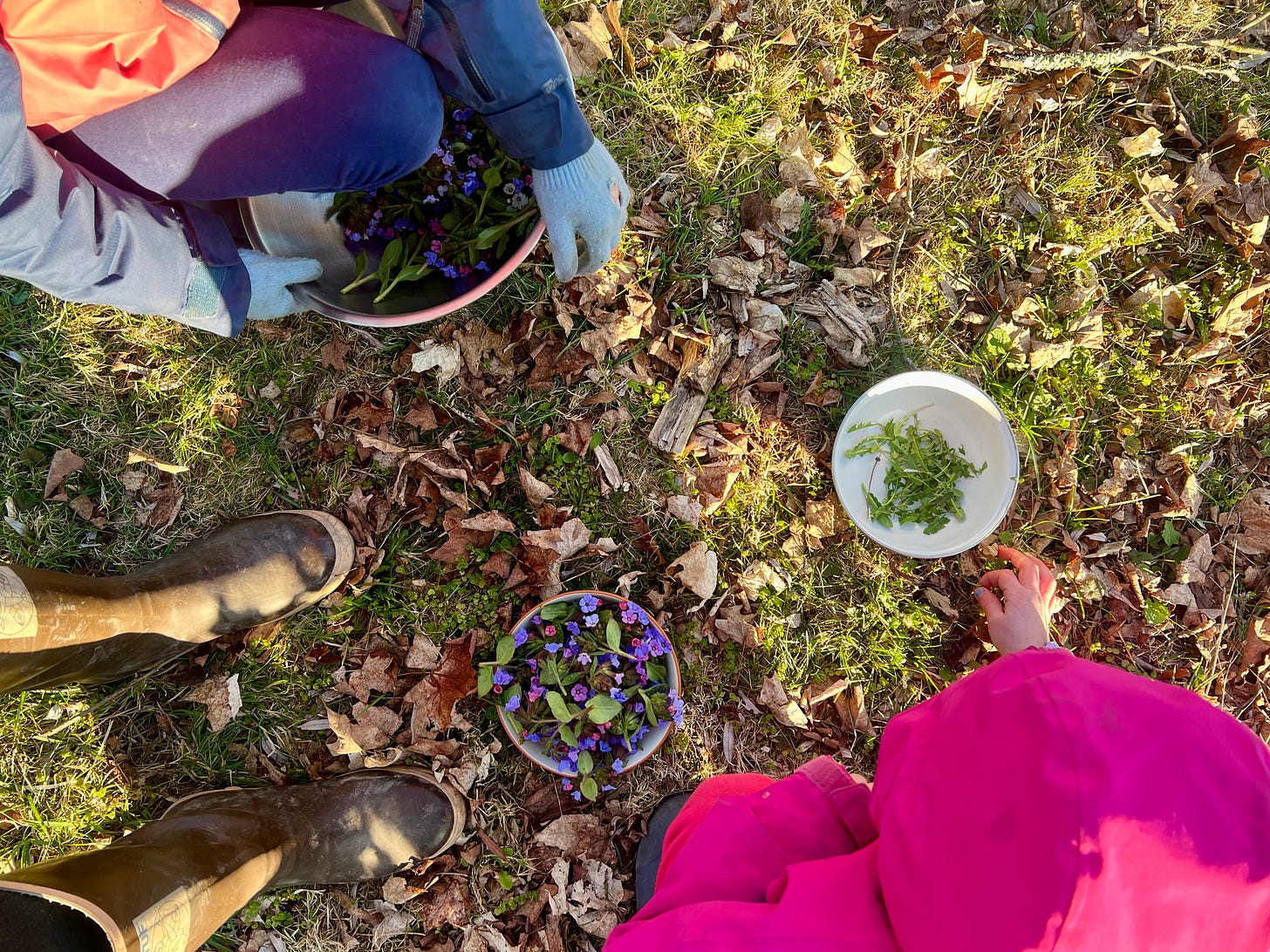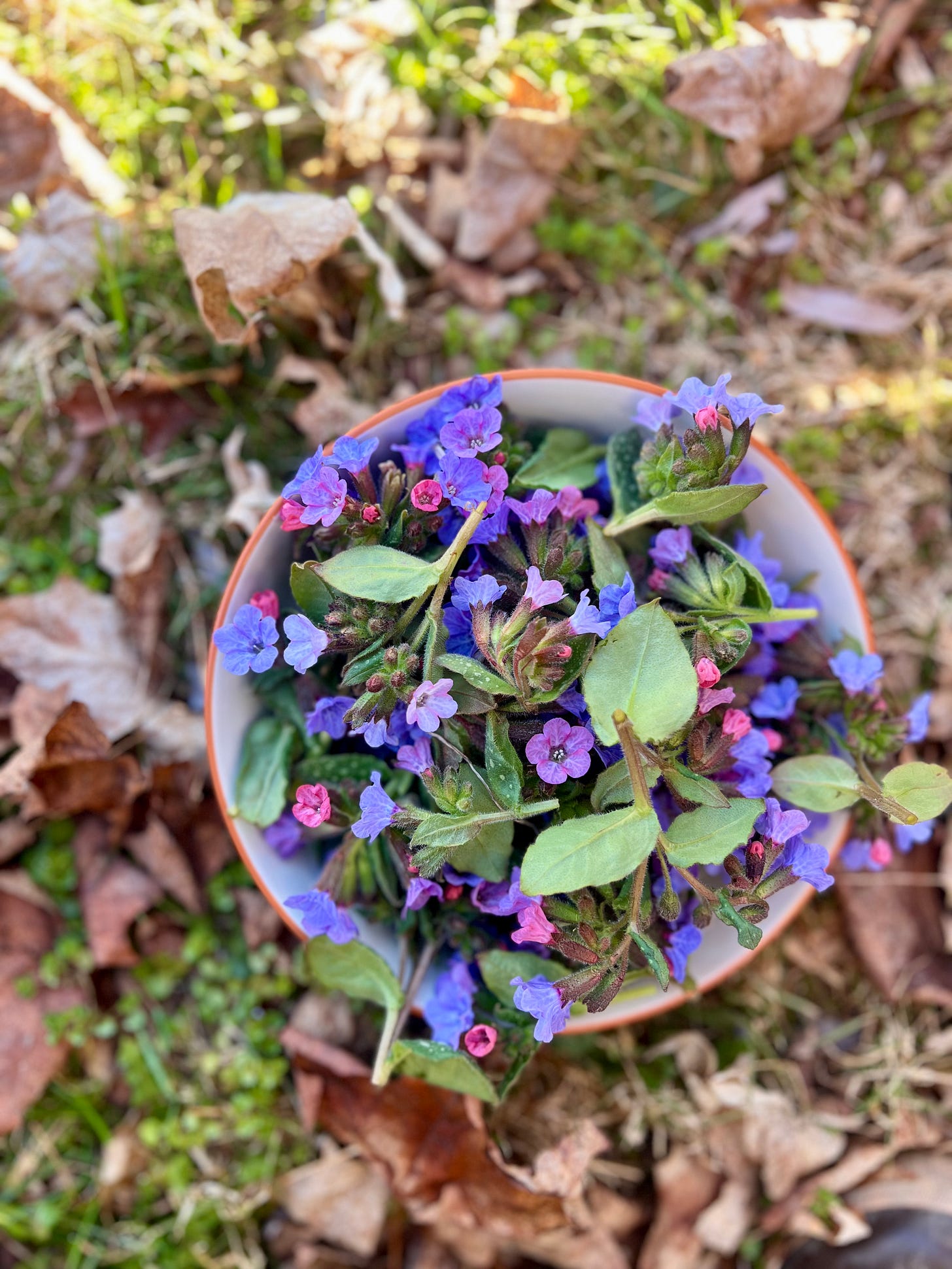Happy Sunday!
As a mother, there are stand-out moments when I think, “Yes! I am doing something right!” (It’s a nice counter-balance to all the face-palm moments.)
One of those happened earlier this week, when the girls ran outside to collect wild edibles for our dinner salad.
(Now, I realize this is a country kind-of-thing, but stick with me…)
It started with the Lungwort flowers (Pulmonaria).
Lungwort’s pink and purple bells bloom amidst white-spotted leaves, thrusting through the rummage of winter with their honeyed stems.
As my eldest was picking them from a patch of milkweed skeletons and mud, she said, we should name them “beauty-bringers!”
When gently picked, the base of the flower has a tube-like shape that holds a single drop of nectar, as Cora demonstrates here:
It’s what the kids and the bees are after.
After the girls’ bowls were spilling with Lungwort (with lots of please’s and thank you’s for the flowers), I had to gently remind them that we only pick what we need, to leave enough for the bees and the plants to re-seed.
At which point, they moved on to find the first tender leaves of Dandelion, Garlic Mustard, and Oxeye Daisy.
They brought their harvest to the kitchen and proceeded to arrange a salad of spinach, garnished with the wild gifts they collected, and drizzled a simple balsamic dressing over top (recipe below).
IMPORTANT: In most cases, wild food should be treated as a a garnish (or as my friend and foraging guide Sarah says, “wild bling”), and not as the main dish—this helps protect our bellies, which may not be used to these foods, and prevent from over-harvesting the plant. Never eat wild food unless you are 110% sure it is edible. Until I am completely familiar with a plant, I like to consult at least 3 foolproof sources: 1-2 experts and/or 1-2 guidebooks.
The girls carried the salad bowl to the table, positively beaming with pride. They had collected dinner!
If you asked me, “what is one thing we can do now to protect our planet for generations to come,” I would say this: teach our children where food comes from and how to cook with it.
One facet of this is learning to forage for wild food, but it includes learning to grow a potted plant on a windowsill at home (as we are doing with pea and tomato seedlings), visiting an urban garden or farm, visiting a farmers market, and other ways of connecting with food grown in your region.
Learning to identify, harvest, and cook with local food:
Is empowering and builds confidence.
Nurtures a reciprocal relationship with the natural world; one where we don’t just take, but we give and protect in return for the gifts we collect and receive.
Helps build healthy habits that can last a lifetime, like eating more fruits and vegetables, and spending time outdoors.
Encourages experimenting with new flavors
Builds connection with people in your community, such as farmers, foragers, grocers, and so forth.
This is a big topic I could talk about for, well, forever…
There are opportunities to befriend plants and become familiar with ingredients wherever you live.
For foraging, you can start learning by joining a plant walk with an expert guide or friend, and begin consulting a book tailored to your region (my favorites are by Samuel Thayer; Nature’s Garden is a great primer).
Start slow. It takes time to build a relationship with a person, and it is exactly the same with a plant. Get to know it in every stage of its life. Learn the many different ways it might offer you food, care, and/or medicine.
It’s never too late to start, and it’s the perfect way to celebrate Spring!
Many holidays are associated with the Spring Equinox, including Easter, Passover, Ostara, and Beltane.
While our family celebrates some of these holidays in our own ways, nothing restores my faith like the simple ritual of welcoming back the flowers and collecting spring salads (whether from the lawn or a local farmers market); a tradition that I imagine has been practiced since the dawn of humanity.
The Earth is always here for us, waiting for us to notice and give thanks.
♡ Emma
BITS & BOBS
Sophia Wronsky of Sophia is Voracious interviewed me about my time on Food Network Star (Season 10). It was really fun to revisit the experience, and dish out some juicy behind-the-scenes stories about what it’s actually like to be on reality TV. We talk about everything from who’s a more critical judge—Alton Brown or my kids—and what I packed for my wardrobe (hint: my twin sister did it for me). Watch or read the interview here.
Check out Witch Way by Jana Blankenship, my dear friend and co-author of Seasonal Family Almanac (on sale on Amazon for $18.40!). Every post is a delicious slurp of Earth-soaked goodness, plus epic playlists for the moment! Read her most recent one: Spring Body Oil Recipe & Pink Moon Playlist.
Consider reading Take Back The Magic: Conversations with the Unseen World. Jana sent me this book after our dog Buddy died, and it has been a fascinating and heart-soothing read. If you’re a spiritual seeker or curious about “the dead,” reincarnation, and the long story of our souls, this book is for you.
If you need a good, cleverly-written show to watch, and you haven’t already, consider Fleabag. I have actively been trying to watch more TV, not a goal you often hear of, I know, but a surefire way to relax (something I could use more of).









This is great